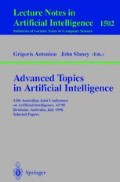Abstract
In [9] we have shown how to construct a 3-layer recurrent neural network (RNN) that computes the iteration of the meaning function T p of a given propositional logic program, what corresponds to the computation of the semantics of the program.
In this paper we define a notion of approximation for interpretations and prove that there exists a feed forward neural network (FNN) that approximates the calculation of T p for a given (first order) acceptable logic program with an injective level mapping arbitrarily well. By extending the FNN by recurrent connections we get a RNN whose iteration approximates the fixed point of T p .
The proof is found by taking advantage of the fact that for acceptable logic programs, T p is a contraction mapping on the complete metric space of the interpretations for the program. Mapping this metric space to the metric space IR the real valued function f p corresponding to T p turns out to be continuous and a contraction and for this reason can be approximated by an indicated class of FNN.
The author acknowledge support from the German Academic Exchange Service (DAAD) under grant no. D/97/29570.
Preview
Unable to display preview. Download preview PDF.
References
K.R. Apt and M.H. Van Emden. Contributions to the Theory of Logic Programming. Journal of the ACM, 29, pp. 841–862, 1982.
S.-E. Bornscheuer. Generating Rational Models. In M. Maher, editor, Proceedings of the Joint International Conference and Symposium on Logic Programming (JICSLP), p. 547. MIT Press, 1996.
K. L. Clark. Negation as failure. In Gallaire and Nicolas, editors, Workshop Logic and Databases, CERT, Toulouse, France, 1977.
P. Devienne and P. Lebégue and A. Parrain and J. C. Routier and J. Würz. Smallest Horn Clause Programs. Journal of Logic Programming, 19(20):pp. 635–679, 1994.
A.S. d’Avila Garcez, G. Zaverucha, and L.A.V. de Carvalho. Logic programming and inductive learning in artificial neural networks. In Ch. Herrmann, F. Reine, and A. Strohmaier, editors, Knowledge Representation in Neural Networks, pp. 33–46, Berlin, Logos Verlag, 1997.
M. Fitting. Metric methods—three examples and a theorem. Journal of Logic Programming, 21(3), pp. 113–127, 1994.
M. Fujita and R. Hasegawa and M. Koshimura and H. Fujita. Model Generation Theorem Provers on a Parallel Inference Machine. Proceedings of the International Conference on Generation Computer Systems, 1992.
K.-I. Funahashi. On the approximate realization of continuous mappings by neural networks. Neural Networks, 2, pp. 183–192, 1989.
S. Hölldobler and Y. Kalinke. Towards a massively parallel computational model for logic programming. In Proceedings of the ECA194, Workshop on Combining Symbolic and Connectionist Processing, pp. 68–77, ECCAI, 1994.
K. Hornik and M. Stinchcombe and H. White. Multilayer feedforward networks are universal approximators. Neuronal Networks, 2, pp. 359–366, 1989.
P.N. Johnson-Laird and R.M.J. Byrne. Deduction. LEA, Hove and London, 1991.
J. W. Lloyd. Foundations of Logic Programming. Springer, 1987.
R. Manthey and F. Bry. SATCHMO: A Theorem Prover Implemented in Prolog. In: E. Lusk and R. Overbeek, editors, LLNCS 310, Springer, pp. 415–434, 1988.
T. A. Plate. Distributed Representations and Nested Compositional Structure. PhD thesis, Department of Computer Science, University of Toronto, 1994.
J. Slaney. Scott: A model-guided theorem prover. In Proceedings of the International Joint Conference on Artificial Intelligence, pp. 109–114, 1993.
P. Smolensky. On the Proper Treatment of Connectionism. Behavioral and Brain Sciences, 11, pp. 1–74, 1988.
A. Sperduti. Labeling RAAM. Technical Report TR-93-029, International Computer Science Institute, Berkeley, Ca, 1992.
S. Willard. General Topology. Addison-Wesley, 1970.
Author information
Authors and Affiliations
Editor information
Rights and permissions
Copyright information
© 1998 Springer-Verlag Berlin Heidelberg
About this paper
Cite this paper
Hölldobler, S., Kalinke, Y., Störr, HP. (1998). Recurrent neural networks to approximate the semantics of acceptable logic programs. In: Antoniou, G., Slaney, J. (eds) Advanced Topics in Artificial Intelligence. AI 1998. Lecture Notes in Computer Science, vol 1502. Springer, Berlin, Heidelberg . https://doi.org/10.1007/BFb0095050
Download citation
DOI: https://doi.org/10.1007/BFb0095050
Published:
Publisher Name: Springer, Berlin, Heidelberg
Print ISBN: 978-3-540-65138-3
Online ISBN: 978-3-540-49561-1
eBook Packages: Springer Book Archive

